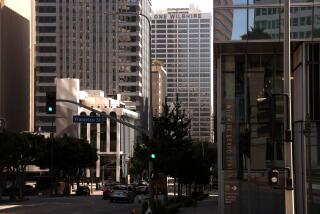There’s No Business Like Show Business for Region’s Developers
In every economic turnaround, there’s a new darling, a booming business that Southern California real estate developers claim will fill up the region’s empty office buildings and justify a whole new round of construction. This time, that golden child is show biz.
With the motion picture business going strong and new television and cable ventures being created almost weekly, builders have lined up plans for more than 5 million square feet of office buildings near the major studios in Glendale and Burbank. Another 3 million square feet of development is planned in Santa Monica, close to where many entertainment industry executives live.
But the building fever has some real estate observers concerned that the industry might be headed down the same thorny path of overdevelopment it took during the last boom when banks and law firms were snapping up new space.
Already, the steel frame for a 24-story high-rise is rising before commuters along the Glendale Freeway. No leases have been signed, but the developers expect to land entertainment tenants.
After all, many of the studios have their own lots to build on, and majors including Warner Bros., Walt Disney Co. and Metro-Goldwyn-Mayer have even put office space back on the market after a series of mergers and consolidations.
Studio executives acknowledge that times are good, but they say developers might be overzealous in their construction plans.
“The studios are expanding, and the number of entities that deal with us are expanding,” said Dan Garcia, head of corporate real estate for Warner Bros. “But if I was a developer, I wouldn’t assume every single square foot would be in Class A-1 office space.”
Much of Warner Bros.’ expansion comes on the production side, Garcia said, which uses less expensive space than the top-grade office buildings planned near the studios that will charge $32 to $35 per square foot annually.
Production facility expansion can be handled in business parks or converted warehouses. Hundreds of thousands of square feet of this so-called creative space have already hit the Westside in recent years, and more is being put on the market every month, researchers say.
In fact, many studios and production companies have already leased or bought buildings like these, well in advance of this development boom. Disney Vice President George Garfield says that after leasing more than 1 million square feet of space during the last few years, he expects the mouse-eared giant to pull back from the market for the next five.
But big studios are just the best-known segment of a vast tenant market. The small firms that work for the majors, like post-production houses and computer graphics shops, are growing exponentially along with the flood of contract work from studios and production companies.
“The world demand for content, especially entertainment-type content, seems to be nearly insatiable,” said Jerry Porter, who heads Brentwood-based brokerage Metrospace/Cresa. And, its audience is increasing, he says, with more demand from overseas and more people looking for entertainment on the World Wide Web.
“Drawing the line between entertainment and technology companies is going to be tougher and tougher,” Porter said. “It isn’t that film companies are going to make twice as many films next year, but they are going to embrace and find new businesses to be in.”
UCLA’s Anderson Forecast predicts that these new businesses should push employment in the entertainment industry ahead of high-tech employment by 2004, a statistic that hasn’t gone unnoticed by the real estate community.
But, as robust as the entertainment business is, it is also unpredictable. One week, a company may need tons of additional space because it has landed work on a new television show or film. But shows get canceled, and film projects eventually end. Even the major studios usually demand short-term leases, a phenomenon that lenders who fund construction aren’t exactly crazy about.
Those are powerful reasons it’s so hard for developers to gauge how much space entertainment companies will need, and it’s why so many office projects that have been announced might never get off the ground.
“Real estate people always over-judge or under-judge when it comes to development,” said Rajeev Dhawan, director of econometric forecasting at UCLA’s Anderson Forecast. “If five get started and there is only demand for two, someone will suffer. That’s the way the business goes.”
The locale most analysts consider ripe for overdevelopment is Glendale, where 680,000 square feet of office buildings are under construction and close to 2 million more square feet are in planning stages. This market got its legs only in 1996, after firms such as Disney and Warner Bros. began spilling over from nearby Burbank. But with more available land for building than its rival, developers expect Glendale to become a new entertainment center.
“It’s always been the bridesmaid market driven by the overflow from Burbank,” said Los Angeles entertainment broker Les Small. A sharp dip in Burbank space rental could kill many of these proposed projects, he added.
Glendale Redevelopment Agency Director Jeanne Armstrong says she doesn’t expect all of the buildings that have been announced to actually hit the market any time soon, perhaps not even the one planned by the agency itself.
“Projects planned and projects constructed are two different things,” Armstrong said, adding that she wouldn’t be surprised if two or three pending developments didn’t get off the ground until the next development cycle.
But the Glendale developers who already have projects underway are spurred by vacancy rates in the low single digits and average rents for all building classes averaging $2.50 per square foot per month. The first few buildings out of the ground should fare well, brokers say.
Trouble will start if too many cash-laden developers begin building later in the cycle, each rationalizing that their project will succeed because of its unique location or on the expectation that Southern California companies will continue to expand as rapidly as they have been.
Developers, who generally have more of their own money tied up in projects this time around, claim to be more realistic and conservative than they were in the last boom.
“If the entertainment industry continues to grow at the same pace, we could get $50 a foot [per year]. That would be great,” said Cliff Goldstein, partner in Los Angeles-based J.H. Snyder & Co., which is beginning construction on two separate entertainment-related office projects in Burbank and Glendale. “But we would be thrilled if it continues to grow at one-third the rate it is now,” he said.
Snyder is beginning construction next month on two office buildings catering to entertainment firms--phase two of the Water Garden in Santa Monica and Burbank Media Center, which is wedged between Warner Bros. and NBC.
These buildings, which should command annual rents of more than $34 a foot, will take about two years to complete. Where the market will be by then is anyone’s guess.
One need only look back at what happened in the last development go-round to see how quickly things can nose dive, even in a popular market such as Santa Monica. After the first phase of the Water Garden and several other large buildings were completed in late 1991, vacancy in Santa Monica soared, reaching a high of more than 25% in the fourth quarter of 1991.
Some analysts suggest that perhaps developers should be looking to the past for clues about how much building is too much. Even at the real estate industry’s peak in 1990, only about 1.7 million square feet of space were leased in the East San Fernando Valley, Glendale and Santa Monica, according to Grubb & Ellis Co. At that unprecedented rate, it would take about five years to lease all of the office space now proposed.
More to Read
Inside the business of entertainment
The Wide Shot brings you news, analysis and insights on everything from streaming wars to production — and what it all means for the future.
You may occasionally receive promotional content from the Los Angeles Times.










